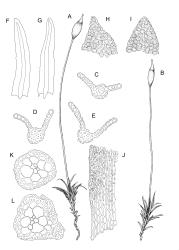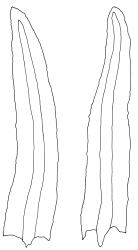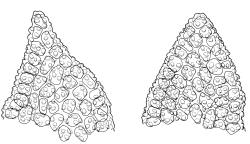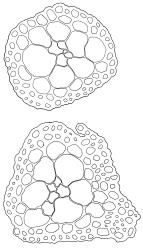- = Gymnostomum angustatum C.Knight, Trans. & Proc. New Zealand Inst. 7: 355 (1875)
- = Gymnostomum pygmaeum R.Br.bis, Trans. & Proc. New Zealand Inst. 26: 298 (1894)
- = Gymnostomum calcareum var. australe Broth. & Geh. in Geheeb, Rev. Bryol. 24: 66 (1897)
- = Weissia torlessensis R.Br.bis, Trans. & Proc. New Zealand Inst. 31: 439 (1899)
- = Gymnostomum gibsonii R.Br. bis, Trans. & Proc. New Zealand Inst. 35: 327 (1903)
- = Gymnostomum parisii R.Br.bis, Trans. & Proc. New Zealand Inst. 35: 328 (1903)
- = Gymnostomum salmonii R.Br.bis, Trans. & Proc. New Zealand Inst. 35: 327 (1903)
- = Gymnostomum calcareum var. longifolium Dixon, Bull. New Zealand Inst. 3: 116 (1923)
Plants pale yellow-green above, light brown below, forming moderately dense to very dense turves. Stems 2–15(–20) mm, often densely matted together below with brown tomentum, in cross-section central strand and sclerodermis present, hyalodermis absent. Leaves erect-spreading to recurved when moist, appressed and slightly twisted with apices sometimes incurved when dry, 0.5–1.5 mm, ligulate to lingulate, carinate, but often flat at the apex, which may be apiculate, acute or rounded, and variable even on the same stem; margins plane, papillose; upper laminal cells somewhat obscure, irregularly rounded-subquadrate, short-rectangular, triangular, or sometimes oblate, firm-walled, pluripapillose with complex papillae, (6–)7.5–10(–12) × (6–)9–11(–12) µm, becoming longer and less densely papillose towards the leaf base; lower laminal cells c. 4×1, firm-walled, smooth, with 1 or 2 rows shorter and/or narrower at the margin forming a weak border. Costa concolorous, stout, failing (2–)5–10 cells before the lamina apex; adaxial superficial cells rectangular, firm-walled, papillose in distal ½ of leaf or occasionally for its entire length; abaxial superficial cells vermicular, very thick-walled, papillose in distal ½ to ¾; in cross-section with 1 stereid band. Axillary hairs c. 4 cells in length, basal cell brown. Laminal KOH colour reaction yellow.
Reportedly dioicous (Sainsbury 1955). Perichaetia terminal, inner leaves with sheathing bases comprising elongate, smooth cells, firm-walled and extending for ≥½ leaf length. Perigonia not seen. Setae slender, 3–9 mm, pale yellow, becoming brown when senescent. Capsules ovoid to ovoid-cylindric, pale yellow-brown, red at the mouth, with exothecial cells thin-walled and bulging. Operculum rostrate, with a suberect obtuse beak from a conical base, ⅓–⅔ the theca length. Peristome absent. Spores 9–14 µm, smooth.
Scott & Stone 1976, pl. 33 (pro parte); Smith 2004, fig. 93, 1–5; Lüth 2019, p. 516; Malcolm et al. 2020, pp. 535–537.
The slender, usually densely packed, pale yellow-green shoots with variously shaped leaf apices are characteristic. The apices vary from rounded to apiculate, even on the same stem. Conspicuously pluripapillose upper laminal cells give a dull hue to dry shoots. When fruiting, the thin, yellow setae (which become light brown when senescent), smooth capsules, and absence of a peristome are also useful aids to identification in the field.
Confusion has occurred with other members of the Pottiaceae, especially Anoectangium aestivum, and those species that have rounded leaf apices and a failing costa, viz. Geheebia ceratodontea, G. tophacea, and the three small species of Tridontium (T. cockaynei, T. milleneri, and T. milleneri). All are characteristic species of wet rock, and from them all Gymnostomum calcareum differs in having variously shaped leaf apices. In Anoectangium aestivum leaf apices are acuminate, and the terminal cell usually has a single terminal papilla (vs. a pluripapillose terminal cell in G. calcareum). The darker olive- or brown-green coloration of Geheebia species will separate them (vs pale yellow-green in Gymnostomum calcareum). Tridontium milleneri differs similarly in colour, and usually has cucullate leaf apices (vs flat leaf apices in G. calcareum); T. novae-zelandiae is a minute plant with stems only 1–2 mm high (vs 2–20 mm high in G. calcareum). More problematic is Tridontium cockaynei; there the laminal cells have 1–2 simple papillae (vs >2 complex papillae in Gymnostomum calcareum). When capsules are present, the short, erect peristome will differentiate T. cockaynei (vs peristome lacking in G. calcareum).
Zygodon intermedius could also be confused, but there the consistently acute leaf apices and a costa that is either smooth, or papillose abaxially in its distal portion only, are diagnostic (vs a costa that is conspicuously papillose abaxially nearly to its base in G. calcareum). When capsules are present, the strongly ribbed thecae of Z. intermedius will readily differentiate it. In addition, the often epiphytic occurrence of Zygodon intermedius contrasts with the exclusively epilithic or terricolous substrate of G. calcareum.
Ardeuma recurvirostrum is a very rare species in N.Z., which could conceivably be passed over for Gymnostomum calcareum. Its leaves when dry have a metallic sheen (vs a matt surface in G. calcareum) and frequently a sigmoid leaf stance when moist (vs leaves erect-spreading in G. calcareum).
NI: N Auckland, S Auckland, Gisborne, Hawke’s Bay, Taranaki, Wellington; SI: Nelson, Marlborough, Canterbury, Westland, Otago, Southland; Ch.
Pantemperate. Tasmania*, mainland Australia*, Europe*. Reported from New Caledonia (Pursell & Reese 1982), from Chile (He 1998), and from S. Africa (Smith 2004).
A very common species on calcareous substrates, such as limestone or sandstone rock, calcareous soil, and artificial substrates such as concrete, mortar, crushed shell paths, or calcareous midden material. The appearance of plants can differ markedly according to habitat: in the Ruahine Range (Wellington L.D.) shoots were seen growing as a tight sward only 2 mm high in a dry rock shelter, but as lax cushions with shoots >20 mm on the dripping walls of a limestone gulch, only 1 km distant (Beever 2009). Associated species include Fissidens asplenioides, F. leptocladus, Geheebia ceratodontea, Tetracoscinodon irroratus, and Tridontium milleneri.
Records range from near sea level to 1400 m (Lake Peel, Nelson L.D.).
Gymnostomum aeruginosum Sm. was recorded for N.Z. (as "Austr2") by Zander (1993). Sometimes regarded as synonyms (e.g., by Zander 1977; Magill 1981), the rather similar G. calcareum and G. aeruginosum have, however, been regarded as distinct in Europe (e.g., Newton 1983; Smith 2004; Frey et al. 2006), and latterly in North America (Zander et al. 2007). Catcheside (1980) likewise did not accept the synonymy, and placed South Australian material in G. calcareum on the basis of several leaf characters. N.Z. plants also match descriptions of G. calcareum s.s. as described in the literature cited above, including the sporophyte characters given emphasis by Zander et al. (2007). There the emphasis was placed on the presence of a distinct, constricted, circumstomal collar and bulging exothecial cells, which are 25–35(–50) µm wide (c. 25–36 µm in N.Z. material), as opposed to 20–25 µm wide in Gymnostomum aeruginosum. Nuclear ITS data from N.Z. samples (CHR 626623; CHR 626624; CHR 626625), when compared with European samples, support the view that the N.Z. moss belongs to G. calcareum and is clearly distinct from G. aeruginosum (O. Werner, pers. comm., 25 May 2016).
Gymnostomum parisii R.Br.bis was placed in synonymy of Gymnostomum calcareum by Dixon (1923). Although type material has not been located, there is no good reason to doubt Dixon’s conclusion.










